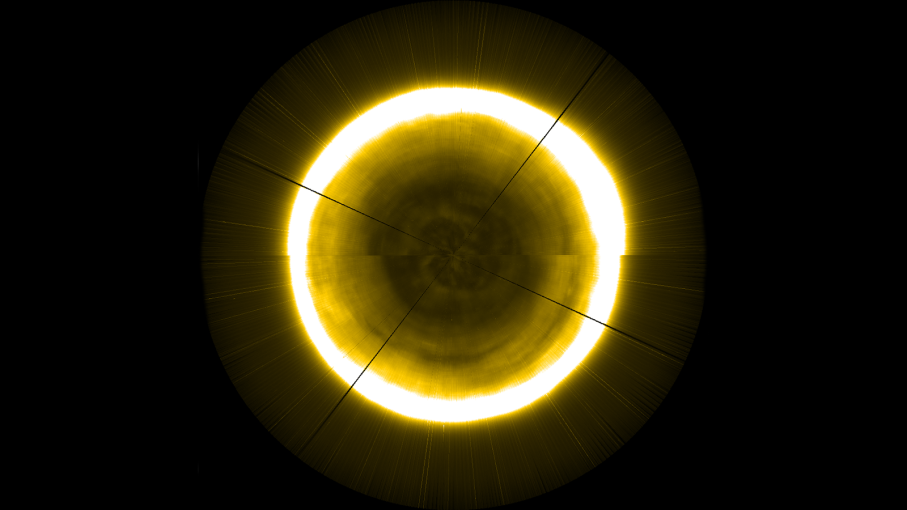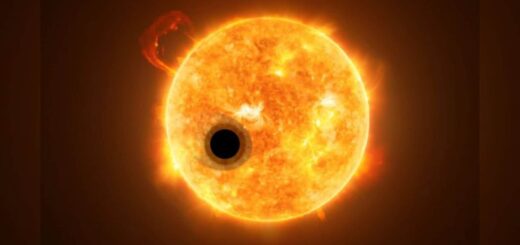This Is a First: An Image of the Sun’s North Pole

The European Space Agency’s new image of the sun’s north pole wasn’t taken by a camera. Instead, it’s an artificial rendering of what the solar north pole probably looks like. ESA/ROYAL OBSERVATORY OF BELGIUM
Polar regions are magnets for explorers. By the year 1926, Earth’s North and South poles had received their first human visitors. Since then, mankind has investigated the tops — and the bottoms — of numerous other worlds across our solar system. Thanks to satellite footage, we now know that there are deep craters near the lunar poles whose bottoms have been shrouded in darkness for billions of years. And over on Mars, the north pole is flanked by a swath of dune fields that’s big enough to smother Texas.
Other environments aren’t as well-documented. Thus far, nobody has managed to snap a picture of our sun’s northern pole. Yet the European Space Agency (ESA) recently did the next-best thing. On Dec. 3, 2018, a spectacular image was uploaded to their website. Using data from existing photographs, the organization painstakingly created a digital reconstruction of that blazing frontier, the solar north pole.
Out of Sight, But Not Out of Mind
Pointing cameras at our nearest star is a time-honored tradition. The first photograph ever taken of the sun was made by the French physicists Hippolyte Fizeau and Leon Foucault way back in 1845. Planet Earth’s surface was their obvious vantage point, but during the 20th century, the dawn of artificial satellites and space probes enabled us to launch imaging tech into space — and closer to the sun.
Over the years, that’s led to plenty of wonderful photo ops. The Yohkoh spacecraft alone captured 6 million images of the sun while it was traveling in low-Earth orbit from 1991 to 2001. Other vessels — like the Helios 2 probe that launched in 1976 — left Earth far behind and took laps around the sun itself.
Despite these technical achievements, the fact remains that we have yet to photograph either of the sun’s poles from directly above or below. Earth orbits the sun on the ecliptic plane, an imaginary line that almost lines up with the star’s equator. (Technically, the solar equator is tilted 7 degrees relative to said plane.)
Most of our space vessels have historically traveled along this ecliptic plane. So as a result, when we aim image-capturing equipment at the sun, the gear is usually moving parallel to lower solar latitudes that are closer to the sun’s equator than they are to either pole.
One object that did break free of the ecliptic plane was the Ulysses space probe. NASA, the ESA and the Canadian Science Council joined forces to create this groundbreaking machine, which used Jupiter’s gravity to shoot itself into a north-south polar orbit around the sun. But although Ulysses carried X-ray, gamma ray and particle-measuring gear, it didn’t take any photos. What a pity.
Educated Guesswork
The ESA’s head-turning new image wasn’t taken by a camera. Instead, it’s an artificial rendering of what the solar north pole probably looks like.
Putting this likeness together was a real technical challenge. Fortunately, the ESA had lots of useful data to draw upon. On Nov. 2, 2009, the agency launched Proba-2, a small satellite with onboard solar-monitoring equipment. Though it revolves around Earth, the craft’s trajectory gives it a mostly unimpeded view of the sun from January to November.
Hardworking ESA scientists reviewed — among other things — Proba-2’s photographs, X-rays and ultraviolet readings of the sun. Their satellite could only view the sun in profile, but these observations did offer some nice info about the star’s uppermost recesses.
They paid particular attention to how the sun’s outer atmosphere behaved as the celestial body rotated on its axis. Over the course of a solar day, the ESA noticed slight atmospheric changes taking place near the poles. The shifts offered up clues about that elusive northern pole and its mysterious appearance.
Crisp Kringle
According to the Proba-2 Science Center, the ESA plans to keep making adjustments to its solar north pole reconstruction images. Because the sun is a big, hot ball of nonsolid plasma, individual areas along the star’s surface often rotate at different speeds depending on their latitudes. As our knowledge of this phenomenon evolves, future ESA images will have to respond in kind.
A planned space mission should allow us to verify just how accurate the current picture is. Come 2020, the European Space Agency will launch its Solar Orbiter, a heat-resistant satellite that’ll orbit the sun at high latitudes. Upon arriving, it should be able to take some long-sought photos of what those poles actually look like.
Studying our sun’s polar regions should help us monitor solar winds, charged particle streams that can screw up our GPS systems. Who knows what the Solar Orbiter will discover, but for now, at least there’s one thing we can say with absolute certainty. Since our sun’s surface temperature is about 10,000 degrees Fahrenheit (5,500 degrees Celsius), the solar north pole is way too hot for Santa Claus.



 Creators of mankind
Creators of mankind Description of “Tall white aliens”
Description of “Tall white aliens” Where they came from?
Where they came from? About hostile civilizations
About hostile civilizations The war for the Earth
The war for the Earth “Tall white aliens” about eternal life
“Tall white aliens” about eternal life Video: “Nordic aliens”
Video: “Nordic aliens” Aliens
Aliens Alien encounters
Alien encounters The aliens base
The aliens base UFO
UFO Technology UFO
Technology UFO Underground civilization
Underground civilization Ancient alien artifacts
Ancient alien artifacts Military and UFO
Military and UFO Mysteries and hypotheses
Mysteries and hypotheses Scientific facts
Scientific facts


















